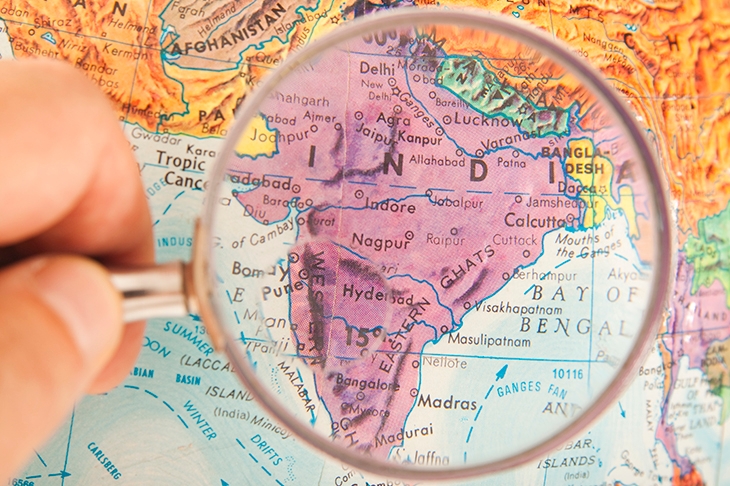Pangong Lake is the most unlikely of places for a naval conflict between two of the world’s nuclear powers, India and China, with a third, Pakistan, looking on with not a little interest.
Lying some 280 miles east of Islamabad, 360 miles north of New Delhi and 2,170 miles west of Beijing, Pangong Lake is in the remote northern Himalayas. In 1905, the explorer Ellsworth Huntington said that its beauty could ‘rival, or even excel, the most famous lakes of Italy or Switzerland’. It is a harsh world, frozen in winter, inhabited by a sparse indigenous population of hardy goat herders. And it’s situated in the southernmost spur of the Aksai Chin, a part of Ladakh (literally ‘the land of the high passes’) that, along with Jammu and Kashmir, form the disputed provinces now partitioned by India and Pakistan.
However, it is another Line of Control to the east that divides Indian-controlled Ladakh from the Aksai Chin: a 16,400-feet-high plateau the size of Switzerland, which is claimed by India but has been occupied by China since Mao Zedong’s armies annihilated those of Prime Minister Nehru in the 1962 Sino-Indian War.
Further Sino-Indian border clashes took place in 1967 and 1975. Then in 1999 the dynamics of Pangong Lake changed when China built a road along its side of the Line of Control and launched a flotilla of five-man speedboats. In the years since, numerous micro-incursions have been made by China. In May and June this year, scuffles between patrolling forces finally led to a violent confrontation in the Galwan Valley to the north of Pangong Lake in which 20 Indian soldiers, including their commander, were killed.
Some alarmist press reports in the West have portrayed these border incidents as presaging a superpower war. However, China’s long-term struggle for supremacy with India will not be along their 2,520-mile land border. Apart from a tactical nibble here and there, China has little to gain from expansion into these resource-poor areas. It took most of what it needed in the 1962 war.
So what is China’s Indian containment strategy? India is hemmed in by Chinese-controlled Tibet in the north-east while in the north-west it borders its immutable enemy Pakistan — a country whose post-war alliance with China is as rock-solid as any in Asia. The forthcoming geopolitical struggle for supremacy between China and India will not be on land. It will be on water and a much larger body of water than Pangong Lake. The Bay of Bengal and the Andaman Sea will become the defining battleground.
Xi Jinping’s ‘Maritime Silk Road’ policy is less talked about in the western press than ‘One Belt One Road’. The economic and military strategy is to dominate the sea lanes between China and the Middle East. As in the ancient Chinese board game of territorial control, Go, which inspired the great military theorist, Sun Tzu, Xi’s China is in the process of placing ‘stones’ (Go’s playing pieces) on Asia’s maritime seaboard that will enable it to achieve this dominance.
China’s first offshore naval port in Djibouti, adjacent to the Suez Canal, is already built. Pakistan’s Chinese-financed port of Gwadar on the Arabian Sea, guarding the approaches to the Strait of Hormuz, is another one of the stones. Closer to home, China, by its placement of airfields and naval facilities on reclaimed reefs in the Spratly Islands, has now gained probably irreversible control of the South China Sea.
From China’s viewpoint this is not enough. A third of global shipping and most of China’s oil imports pass through the Strait of Malacca between Singapore and the Indonesian island of Sumatra. As a Portuguese envoy noted in the 16th century, ‘whoever is lord of Malacca has his hands on the throat’. With the US navy embedded in Singapore’s Changi naval base, China sees the Malacca Strait as the weakest link in its maritime strategy. Thus, the digging of a $30 billion, 80-mile canal across the Kra Isthmus in southern Thailand is being mooted. The canal would bypass the US-controlled Malacca Strait and give China unimpeded access to the Andaman Sea and the Bay of Bengal. Reputedly, Chinese companies are already buying up land around the projected route of the canal. Importantly, over the past 20 years, Thailand, once a staunch US ally, has become a quasi-satellite of China.
Further inroads into the Bay of Bengal are being established by Chinese financing of the new port at Chittagong in Bangladesh, a country whose relationship to India, if not hostile, is nevertheless equivocal. It is somewhat overlooked that Bangladesh, a country of 165 million people, is now one of Asia’s fastest-growing economies.
Myanmar is even more in thrall to China. As the old Burmese saying goes: ‘When China spits, Burma swims.’ Here too China is financing a major port development on the coast of Rakhine state, home of the Rohingyas. In January, during Xi’s state visit to Myanmar, there was a joint announcement that they would push ahead with the construction of a new port in the Kyaukpyu Special Economic Zone. It is planned to link both this and the port in Chittagong by rail and road to Kunming, the capital of western China’s Yunnan Province. An oil pipeline is also planned. Meanwhile in the southern reaches of the Bay of Bengal, the People’s Republic of China and the Democratic Socialist Republic of Sri Lanka have been close allies since the 1950s.
Although India is fully alive to China’s ‘string of pearls’ strategy, the West appears to be asleep. In the 1980s the architect of his country’s ‘capitalist’ renaissance, Deng Xiaoping, warned that China should ‘hide our capacities and bide our time; be good at maintaining a low profile; and never claim leadership’. That philosophy is now redundant. With its economy on an equal footing with that of the United States, and, on current trends, likely to be double its relative size within 30 to 50 years, China under Xi is bent on world leadership even if that ambition remains largely unspoken. It is war-making without gunsmoke; to quote Sun Tzu’s The Art of War, a country should aim to make its ‘position unassailable’ and to break ‘the enemy’s resistance without fighting’.
President Obama, by abandoning pragmatic post-war realpolitik and replacing it with a Carter-esque morality-driven foreign policy, ceded the initiative in Asia to Xi. China’s effective annexation of the South China Sea was met with virtually no policy response. Appeals to international maritime law are pointless; China will ignore legal procedures because it can. At the same time, western politicians’ moral grandstanding about Aung San Suu Kyi’s treatment of the Rohinga in Myanmar, the overthrow of democracy in Thailand, the brutal crackdown on crime by President Duterte in the Philippines and Prime Minister Modi’s perceived anti-Muslim policies in India, have left America bereft of its natural allies in the region — countries that fear the encroachment of Chinese military and economic power but no longer trust US foreign policy to give them consistent support.
[special_offer]
By contrast, as Thailand’s former prime minister Thaksin Shinawatra has noted, not with pique but with admiration, the Chinese ‘just do not care. Whoever becomes the government, they just do business with. They are like entrepreneurs, they do business, they don’t do politics.’ While Donald Trump has begun to resist China’s aggressive mercantilist economic policies, there is as yet little evidence of significant US pushback in terms of supporting and corralling its Asian allies.
With 11 aircraft carriers to China’s two, America still commands maritime Asia. However, the balance is changing rapidly. As the US congressional report on Chinese naval modernization concluded in May, by year end the US will have 297 naval vessels, the same number as 15 years ago; China will have 360, up more than 50 percent over the same period. A third Chinese aircraft carrier is under construction and the hull of a fourth is expected to be laid down next year.
The direction of travel is clear. The US navy could find itself in China’s wake if current trends continue. ‘There is no doubt that they’ve been investing hugely in this,’ says Nick Childs of the International Institute for Strategic Studies. ‘They’ve been outbuilding everybody.’ Unless the West wakes up to the challenge, it is likely to be outgunned within 15 to 20 years by the People’s Liberation Army navy. The European Union, of course, unwilling even to pay for its own strategic defense, is an embarrassing irrelevance. The risk for India and the West is not armed conflict with China. It is that the struggle for supremacy in Asia will be lost with hardly a shot being fired. Sun Tzu would be proud.


















